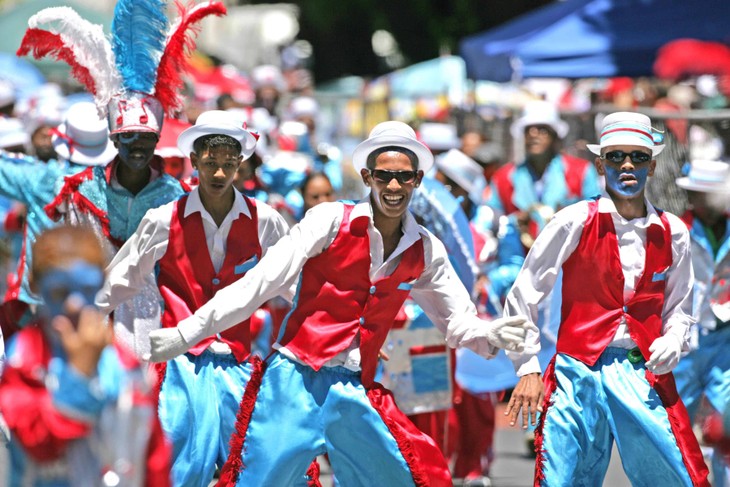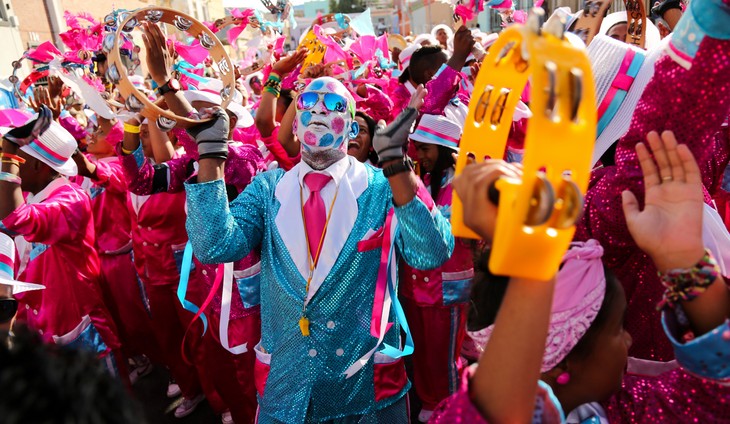(VOVWORLD) - The Cape Town Minstrel Carnival, also known as the Tweede Nuwe Jaar, or Second New Year, is a colorful parade in Cape Town, South Africa. It is as rich in history as in culture. Today we will talk to Ray Smit, a South African who is living in Hanoi to know more about the festival.
Hoang Tung: Hello Ray, welcome to VOV’s Culture Rendezvous. Can you tell us the origin of the carnival?
Ray Smit: To talk about the origin of the carnival, we have to date back to the 19th century, around 1890, and it has something to do with the time of slavery in Cape Town. The Dutch colonialists first included slaves in their New Year celebrations in the mid 1800s, giving them a day off on January 2 to celebrate in their own manner. When slavery was abolished in South Africa in 1834, and the subsequent four-year ‘apprenticeship’ ended in 1838, the event became a celebration of freedom characterized by street processions, music and song., when the original citizens of District Six were allowed their one day off on January 1st.
Hoang Tung: It seems that the festival has more than 1 name, does it?
Ray Smit: Yes. These day, we widely know it as the Cape Town Minstrel Festival. But it is also referred to as Tweede Nuwe jaar, which means Second New Year. However, the festival is called locally as the Kaapse Klopse. Although under Apartheid, it was called the Coon Carnival by Capetonians, local authorities have renamed the festival the Cape Town Minstrel Carnival as the term “coon” is racist and derogatory. Many Capetonians still refer to it as “Coon Carnival”, though.
 (Photo: Cape Town Travel) (Photo: Cape Town Travel) |
Hoang Tung: What are main activities of the festival?
Ray Smit: The lively celebration has many activities. Its main attraction, though, is the Minstrel Parade held on January 2. In this event, many thousands of minstrels, or street performers, march through the city. They wear painted faces and colorful costumes. They are often accompanied by musicians playing banjos, guitars, trumpets, trombones and traditional drums called ghoema. The drums are small wine barrels with skin coverings. Their strong sound helps set the rhythm of the entire parade.
The minstrels are organized into “klopse”, or troupes. Small groups may have a few hundred participants. Larger groups may have nearly 1,000 members. More than 60 different troupes may appear within the Minstrel Parade. The groups rehearse their music and dance numbers for months in preparation for their final performances.
Hoang Tung: As fas as I know, the festival has gone through some difficulties in organizing, particularly at the very first years of establishment. How was the festival during Apartheid?
Ray Smit: Under the Apartheid, the government declared The Group Areas Act of 1966, assigning racial groups to different residential and business sections in urban areas. The Act resulted in communities losing their sense of belonging to the communities they grew up in. The Minstrel performances were spread across the Cape Peninsula to various areas. In 1967, the Carnival was banned from its home at the Green Point stadium. In 1977, all Minstrel marches were forbidden in any part of Cape Town and as a result people lost interest in watching the parade. But the people were very resilient. They moved the event between various stadiums in order to keep it alive until 1989, when the event returned to its original route: from District Six to the Green Point stadium.
Hoang Tung: That’s inspiring. The Cape Town people must have been really strong, haven’t they?
Ray Smit: Yes. I think not only in Cape Town, but all over the world, when it comes to culture preservation, people are very strong and determined. During hard times, Cape Town people managed to preserve their love for music. Malay choirs as well as “klopse” rehearsed and performed in the streets while also influencing the Cape Town Jazz subculture, which developed after World War Two, through the incorporation of the ghoema beat into jazz music. So while there were attempts at interrupting the development of a culture specific to the colored people of Cape Town, it continued to develop within the boundaries they were forced and limited to exist in.
 (Photo: Daily Maverick) (Photo: Daily Maverick) |
Hoang Tung: How about the festival’s music?
Ray Smit: The music associated with Minstrel history and Tweede Nuwe Jaar was influenced by a variety of sources as in the 17th and 18th centuries, slaves were sent to the Cape of Good Hope from many countries, such as Indonesia, Malaysia, Sri Lanka, India and East Africa. And of course, many songs are originated from the Netherlands. Traces of African, Asian and European music can be heard in the Minstrel music. The "ghoema" beat reflects rhythmic similarities of India, Indonesia, Africa and the Middle East. Therefore, "Ghoemaliedjies" (Ghoema songs) are reminiscent of the music from Africa, Asia and Europe. "Melodies" and "moppies" have Western origins and were strongly influenced by African–American music. The cinemas across District Six also exerted the jazz influence and the re-enactment of famous actors and singers in the performances. So, in general, the festival’s music is really diverse.
Hoang Tung: Thank you very much for your interesting information about the festival. Culture rendezvous will be back next week with more fascinating stories about culture around the globe. This is Hoang Tung. Goodbye.